Of Necromancers & Frog Gods – Part One (The Public Life of Sherlock Holmes)
NECROMANCER GAMES
OGL and D20
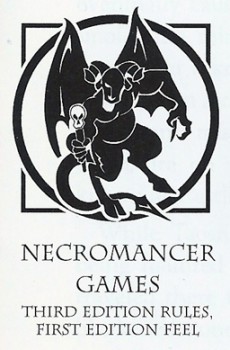 When Wizards of the Coast rolled out the Open Game License for 3rd Edition Dungeons and Dragons, a plethora of third party companies would produce products, leaving players with a seemingly unlimited number of options available for purchase. A few were great, more were terrible and most were in between.
When Wizards of the Coast rolled out the Open Game License for 3rd Edition Dungeons and Dragons, a plethora of third party companies would produce products, leaving players with a seemingly unlimited number of options available for purchase. A few were great, more were terrible and most were in between.
That period was known as the d20 boom, which inevitably led to a d20 bust and is explained in depth in Shannon Appelcline’s tremendous, four-volume RPG history, Designers and Dragons. If you have any interest in role playing history, you will love those books (they are broken up into decades: The Seventies, Eighties, Nineties and Two Thousands).
Along the way, many new and existing companies entered the official Dungeons and Dragons world. One of the most popular and successful was Necromancer Games, founded by Clark Peterson and Bill Webb. Under a different name, Necromancer’s offspring is a major player in the RPG scene today.
The Open Gaming License (OGL) made the 3rd Edition Dungeons and Dragons mechanics permanently “open use” and the basis of a System Reference Document (SRD). The OGL was accompanied by the d20 license, which verified that third party products were compatible with 3rd Edition.
The OGL and d20 licenses had distinguishing characteristics and somebody more versed than I in the intricacies should write a post on that whole shebang. Suffice to say here, companies began rolling out d20 products from day one.
[Click on the images for bigger versions.]
A Necromancer Arrives
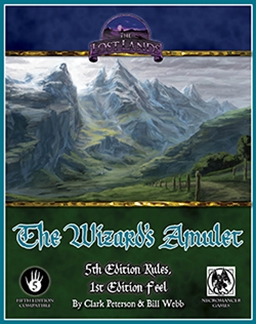
Back to our story! On August 10, 2000, Wizards of the Coast released the 3rd Edition Players’ Handbook at GenCon. At just a few minutes after midnight on the 10th, hours ahead of 3rd Edition’s unveiling, Necromancer Games had put out a free pdf adventure, The Wizard’s Amulet. It was the first widely released d20 supplement, albeit in the less common electronic format.
Atlas Games had released the d20 adventure, Three Days to Kill, locally earlier in the week and it was the first d20 print item on sale at GenCon, with Green Ronin’s foundational Death in Freeport coming out later that same day.
Amulet, which was laid out in a step-by-step fashion for beginner Dungeon Masters, was really just a lead-in to The Crucible of Freya, which came out in December of that year.
The Crucible of Freya (2000)
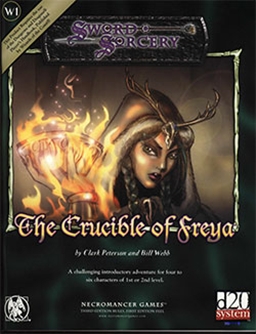 The party, either continuing on from The Wizard’s Amulet or just wandering into the village of Fairhill, is convinced to pursue some Orcs who stole a holy item from the temple of Freya (and burned the place down as well). The characters must infiltrate a ruined keep and possibly deal with a sorcerer who was outsmarted by Orcus! Crucible is a fun adventure that holds up well for first-level adventurers. It is also easy to tie The Wizard’s Amulet and The Crucible of Freya into The Tomb of Abysthor. I’ll talk about the latter in an accompanying article about ‘The Lost Lands.’
The party, either continuing on from The Wizard’s Amulet or just wandering into the village of Fairhill, is convinced to pursue some Orcs who stole a holy item from the temple of Freya (and burned the place down as well). The characters must infiltrate a ruined keep and possibly deal with a sorcerer who was outsmarted by Orcus! Crucible is a fun adventure that holds up well for first-level adventurers. It is also easy to tie The Wizard’s Amulet and The Crucible of Freya into The Tomb of Abysthor. I’ll talk about the latter in an accompanying article about ‘The Lost Lands.’
Founders Clark Peterson and Bill Webb knew that that the d20 license was going to be something big and they didn’t just start on the ground floor. They basically started the ground floor by creating Necromancer Games and getting Amulet out there ahead of The Player’s Handbook. And they went in big from the start by signing a deal with White Wolf.
White Wolf was a giant in the RPG industry, thanks largely to their creation of Vampire: The Masquerade. They recognized the potential of d20 and they were setting up Sword and Sorcery Studios (as well as the Sword and Sorcery imprint: the two were basically the same thing, though) to capitalize on it.
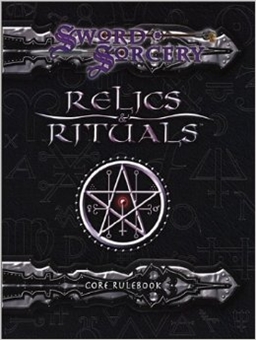
At this point, those who had been a part of the online discussions about d20 and the OGL were the only folks who really knew what it was all about. White Wolf lacked that expertise and they wanted somebody with d20 knowledge to help them manage this effort. The solution was to partner with Necromancer and as part of the deal, they would publish the latter’s products as well.
This was a masterstroke for the fledgling Necromancer. They produced some of the early Sword & Sorcery products like Relic & Rituals and the first two Creature Collection books, which were written by White Wolfers and did not carry the Necromancer Games label. Rather than producing adventures, Sword and Sorcery was focusing on supplements for d20 play early on.
Sword and Sorcery was setting their own products in White Wolf’s new, dark campaign world, The Scarred Lands. It never really established itself as a 3rd edition favorite, though the source books like Relics & Rituals (I and II) still offered much of use to players and are still referenced in Frog God materials today.
Meanwhile, Necromancer focused more on adventures than supplements and was primarily appealing to fans of old school Dungeons and Dragons. Adopting the Demon Lord Orcus as their logo, their slogan was ‘Third edition rules, first edition feel.’ Peterson would describe first edition feel as being:
…about monster choice, playing style, influence, and setting …First Edition is the cover of the old DMG with the City of Brass; it is Judges Guild; it is Type IV demons not Tanaari and Baatezu; it is the Vault of the Drow not Drizzt Do’urden; the Tomb of Horrors not the Ruins of Myth Drannor; it is orcs not ogrillons; it is mind flayers not Ilithids… it is Tolkien, Moorcock, Howard, and Leiber, not Eddings, Hickman, Jordan, and Salvatore…
Adventures R Us
In 2000 and 2001, Necromancer was putting out tough, large combat-filled adventures like Rappan Athuk (The Dungeon of Graves) and The Tomb of Abysthor.
Modular – It may seem odd that several of Necromancer’s best-known adventures are not detailed in this essay. That’s because many are part of Frog God Game’s The Lost Lands campaign world and that is going to be another essay.
Rappan Athuk – The Upper Levels (2001)
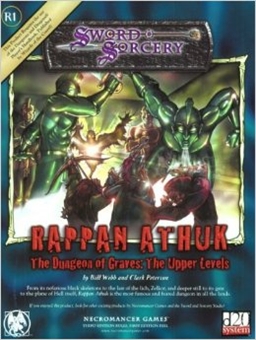 Rappan Athuk was an old school, ridiculously hard dungeon crawl that made Necromancer’s name. 2-The Middle (2001) and 3-Lower Levels (2002) completed the mega dungeon that was something out of Gary Gygax’ nightmares. “Don’t go down the well” became a 3rd Edition battle cry.
Rappan Athuk was an old school, ridiculously hard dungeon crawl that made Necromancer’s name. 2-The Middle (2001) and 3-Lower Levels (2002) completed the mega dungeon that was something out of Gary Gygax’ nightmares. “Don’t go down the well” became a 3rd Edition battle cry.
For me, the coolest part of The Dungeon of Graves is all the mentions about the great battle that took place between the armies of Light and the evil forces of the city of Tsar. I’ll note that it’s also what grabbed Greg Vaughan’s interest (more in the Frog God Games section). Rappan Athuk Reloaded was an almost 400 page revision for 3.5 and Frog God would update it again for Pathfinder with a massively successful Kickstarter.
However, White Wolf’s attention began to grow more divided among its ever-expanding list of projects and Necromancer became less of a priority for Sword and Sorcery.
Necromancer attempted to strengthen its standing by forming partnerships with original Dungeons and Dragons icons Gary Gygax (Necropolis) and Rob Kuntz (three Maze of Zayene modules). This further cemented their “first edition feel” theme.
Necropolis (2000)
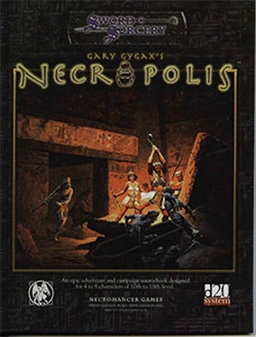 Necropolis, written by Gary Gygax, was first released in 1992 by Games Design Workshop as part of the Dangerous Journeys’ Mythus line. Necromancer converted it into a 284-page (which was a bit hefty for the time) d20 adventure. It is set in the Egyptian-themed land of Khemit. A campaign for 10th-18th level characters (typically Gygax (and Necromancer) deadly, it is also something of a gazetteer, though not quite so much by today’s standards.
Necropolis, written by Gary Gygax, was first released in 1992 by Games Design Workshop as part of the Dangerous Journeys’ Mythus line. Necromancer converted it into a 284-page (which was a bit hefty for the time) d20 adventure. It is set in the Egyptian-themed land of Khemit. A campaign for 10th-18th level characters (typically Gygax (and Necromancer) deadly, it is also something of a gazetteer, though not quite so much by today’s standards.
Necromancer also released Necropolis: Set’s Daughters, which is a tenth level introductory adventure to Gygax’s book. It’s a nice 32-page module to get the players’ feet wet. I think that Necropolis includes some of Gygax’s best work and remains one of the standards for an Egyptian-ish campaign, if rather high level.
Necromancer continued producing popular third edition adventures, such as The Vault of Larin Karr, The Hall of the Rainbow Mage and The Grey Citadel. They also released supplements such as The Book of Taverns and the first Tome of Horrors (a monster collection that has reached four volumes).
The Grey Citadel (2003)
This has remained one of my favorite Necromancer products. For 5th level characters, it is an urban investigation with a dungeon crawl intertwined, set in the city of Dun Eamon. And of course, there’s a Macguffin (if you don’t know what that means, you need to either watch some Alfred Hitchcock films or read The Maltese Falcon).
Being a Necromancer product, the investigation has its dark twist, but it’s pretty cool. Frog God’s The Eamonvale Incursion essentially tackles the rest of the area and isn’t a direct sequel to The Grey Citadel, but it makes sense to run characters through it after successfully completing The Citadel. Incursion is a combination of urban investigation and wilderness adventuring, so it makes a nice complement.
Aiding the DMs
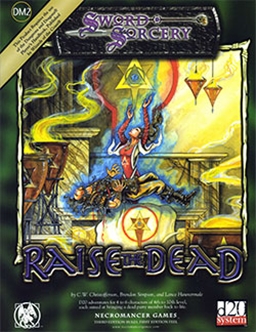 In 2003, a new line came and went. “DM stood for ‘DM Utility (‘W,’ ‘D’ and ‘G’ were already in use. Can you guess what they stood for?). These supplements were “aids for the overworked DM.” DM1 was The Book of Taverns. I think you know what it was about. It contained ten fully fleshed out watering hole/inns, with floor plans, descriptions, histories, NPCs, adventure hooks and even menus. Apparently to stand out, they were mostly rather exotic and unconventional.
In 2003, a new line came and went. “DM stood for ‘DM Utility (‘W,’ ‘D’ and ‘G’ were already in use. Can you guess what they stood for?). These supplements were “aids for the overworked DM.” DM1 was The Book of Taverns. I think you know what it was about. It contained ten fully fleshed out watering hole/inns, with floor plans, descriptions, histories, NPCs, adventure hooks and even menus. Apparently to stand out, they were mostly rather exotic and unconventional.
DM2, Raise the Dead, was more interesting. According to lead author Casey Christofferson, it “came about because GMs on the Fangsfall chat(group) hated the thought of characters getting raised and becoming powerful for some odd White Wolf only knows reason. We thought what a great way to incorporate a good quest into raising characters that wouldn’t otherwise be brought back to life.”
Or, as the introduction asked, “Should getting raised from the dead be reduced to the same procedure as buying 50 feet of rope?” No “supermarkets of resurrection” here!
Raise the Dead (2003)
This supplement offers four adventures for parties that lost a member and want to bring them back to life. It is suggested that the player of the dead character play an NPC for the adventure, so that they’re not left out for a session or two. In one adventure, the party quests for a major artifact, The Rod of Arden. Arden was a slain God of the Sun and another of his artifacts had been the quest goal in one of the Demons and Devils (released in 2001) adventures. It’s a shame all the Necromancer modules and myths were never tied together into a campaign world (Fear not! Read on).
There would be similar themed supplement/adventures, such as Dead Man’s Chest and Glades of Death, but the DM line was terminated after just two entries.
Moving to 3.5
Necromancer continued on as 3.5 supplanted 3.0 (there’s another interesting topic for a post) and some of their best work came during this period.
The Bonegarden (2004)
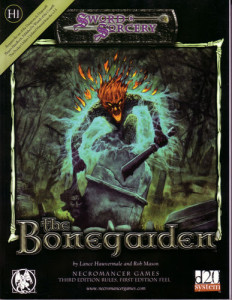
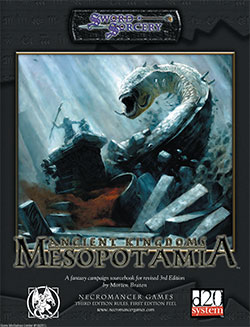 This one typifies what Necromancer Games was aiming for, I feel. The Bonegarden is a giant cemetery. Within, the dead roam freely. Any who are slain by brave adventurers return to life the next night. Which means there’s an inexhaustible supply of enemies. There is no storyline. Now, there are elements and adventure hooks that the Game Master can utilize and fashion into a plot, but basically, it’s a giant undead playground that a GM can make the setting for any quest of their choosing. Oh yeah: any living thing can’t get out on their own without a good Cleric’s aid. Designed for levels 12-14, this freeform, enclosed sandbox, is HARD. Clerics Wanted! Please Apply Inside.
This one typifies what Necromancer Games was aiming for, I feel. The Bonegarden is a giant cemetery. Within, the dead roam freely. Any who are slain by brave adventurers return to life the next night. Which means there’s an inexhaustible supply of enemies. There is no storyline. Now, there are elements and adventure hooks that the Game Master can utilize and fashion into a plot, but basically, it’s a giant undead playground that a GM can make the setting for any quest of their choosing. Oh yeah: any living thing can’t get out on their own without a good Cleric’s aid. Designed for levels 12-14, this freeform, enclosed sandbox, is HARD. Clerics Wanted! Please Apply Inside.
Ancient Kingdoms: Mesopotamia (2004)
This is the first module from Morten Braten, who would go on to create the pulp-inspired ‘World of Xoth.’ It is a historical fantasy version of Mesopotamia, the area that included Assyria and Babylon. The first part is a campaign world, complete with new races, classes, spells, feats, etc. and the second part is full of adventures in the area. Think of Gilgamesh’s adventures.
Clark Peterson listed this as one of his five favorite Necromancer products, saying, “The low-fantasy sequencing of this one is very Conanesque.” And I can’t think of any other module that opens with a quote from The Book of Genesis!
The Gygax and Kunz relationships were brief, but Necromancer would again turn to the old school and licensed some Judges Guild properties: The Caverns of Thracia, The Wilderlands of High Fantasy and City State of the Invincible Overlord).
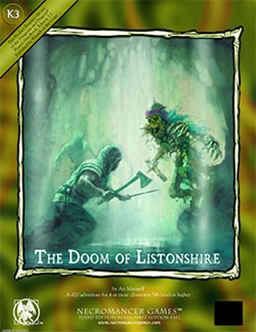 As Black Gate editor John O’Neill said, “…perhaps their crowning achievement, the Wilderlands of High Fantasy boxed campaign set, which has become one of the most sought-after gaming products of the 21st Century.”
As Black Gate editor John O’Neill said, “…perhaps their crowning achievement, the Wilderlands of High Fantasy boxed campaign set, which has become one of the most sought-after gaming products of the 21st Century.”
One of the strengths of Necromancer was that they offered a smorgasbord of items. There were straight modules, like What Evil Lurks and Aberrations. They also produced mini-campaigns, such as The Lost City of Barakus, A Lamentation of Thieves and Trouble at Durbenford. These mini-campaigns often ran over 200 pages, which was less common in those hardback book days of RPGing.
Their adventures offered a lot of variety in content and depth. The Siege of Durgam’s Folly (2001) was centered on a clockwork golem. Chaos Rising (2003) had the party up against the machinations of the Demon Lord Jubilex (because dealing with Orcus’ plots isn’t enough…). Trouble at Durbenford (2004) is another mini-campaign (8th – 14th level) that involves urban, wilderness and dungeon adventuring. The Doom of Listonshire (2005) is a well-plotted adventure that starts with an entire royal family being wiped out by Ogres. Necromancer’s adventures were tough and most often a bit dark.
And, they rolled out gorgeous boxed sets, including City of Brass, Rappan Athuk Reloaded and The Wilderlands of High Fantasy.
Wilderlands of High Fantasy (2005)
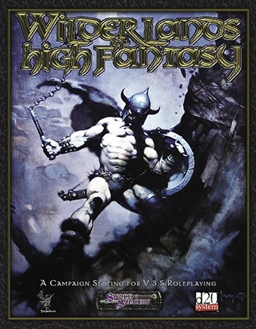 John O’Neill wrote about this superb overhaul of the classic Judges Guild campaign setting that, for some of us, was the world of choice over Greyhawk. It contains nearly 550 pages of material, with another 135 in a Player’s Guide. It is one of the best product updates I have ever seen. Unfortunately, the rights to the Wilderlands reverted back to Judges Guild in 2006.
John O’Neill wrote about this superb overhaul of the classic Judges Guild campaign setting that, for some of us, was the world of choice over Greyhawk. It contains nearly 550 pages of material, with another 135 in a Player’s Guide. It is one of the best product updates I have ever seen. Unfortunately, the rights to the Wilderlands reverted back to Judges Guild in 2006.
Judges Guild (which is currently floundering their way through a Kickstarted update of The City State of the Invincible Overlord) might have remained relevant through ensuing editions (and perhaps Pathfinder) if they had not pulled their properties back from Necromancer.
Necromancer’s Invincible Overlord revision clocked in at almost 300 pages and, if dropped into the new Wilderlands, provided enough adventuring and setting for an RPG lifetime. Too bad Necromancer didn’t get to converting City State of the World Emperor as well.
Necromancer also put out DM aids that included mini-adventures, such as Glades of Death and Dead Man’s Chest, plus monster collections like Tome of Horrors III, as well as things like Flying Buffalo’s The Wurst of Grimtooth’s Traps, et al.
Glades of Death (2005)
Similar to the pirate-themed Dead Man’s Chest, this was a GM’s source book containing new skills, feats, spells, monsters and adventures around a forest theme. The GM could incorporate elements into his current campaign, or run the adventures contained within Glades. I myself used some of this book recently for a Pathfinder Falcon’s Hollow campaign. Frog God Games has continued this series, updating Chest (as part of the Razor Coast Kickstarter) and creating new entries, such as Dunes of Desolation.
Publishing Partners
White Wolf grew more and more busy with its own efforts and other partnerships, providing less support. Necromancer addressed this problem by finding other partners to supplement their agreement with White Wolf.
Troll Lord Games
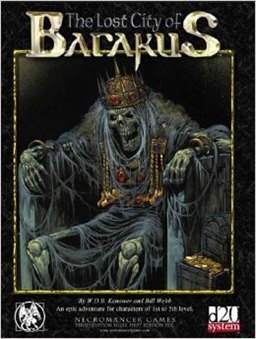 First, they signed a deal with Troll Lord Games. At GenCon 2000, the newly formed Troll Lord introduced a new line intended for use with AD&D. Of course, that’s the same convention where 3rd Edition was announced! They survived this hiccup, joined the d20 stampede and signed Gary Gygax and Rob Kuntz on to write for them! Troll Lord served as publisher for five Necromancer products in 2004 and 2005, including the excellent The Lost City of Barakus (which would be revived by Frog God for The Lost Lands). Troll Lord is still going strong with their retroclone (more on those in Part Two), Castles & Crusades, which our own John O’Neill wrote about here. But it was a short-lived agreement and Necromancer would move on to another partner.
First, they signed a deal with Troll Lord Games. At GenCon 2000, the newly formed Troll Lord introduced a new line intended for use with AD&D. Of course, that’s the same convention where 3rd Edition was announced! They survived this hiccup, joined the d20 stampede and signed Gary Gygax and Rob Kuntz on to write for them! Troll Lord served as publisher for five Necromancer products in 2004 and 2005, including the excellent The Lost City of Barakus (which would be revived by Frog God for The Lost Lands). Troll Lord is still going strong with their retroclone (more on those in Part Two), Castles & Crusades, which our own John O’Neill wrote about here. But it was a short-lived agreement and Necromancer would move on to another partner.
Kenzer & Company
Moving on from Troll Lord, Necromancer signed a deal with Kenzer & Company in 2005. Kenzer & Co. is best known for Knights of the Dinner Table and the Hackmaster system. Headed up by lawyer David Kenzer, it was one of the few to successfully take on Wizards of the Coast about trademark use of the Dungeons & Dragons brand.
From K1: A Family Affair through K7: Tower of Jhedophar (for 14th-16th levels!), Kenzer published seven Necromancer adventures in 2005 and 2006. K8 either wasn’t used or was The Mother of All Treasure Tables (it’s not on the cover), and K9: Elemental Moon, was one of the final Necromancer products before the great hiatus (Sherlock Holmes reference for you there).
The End is Nigh
But by the end of 2006, the d20 decline was in full swing. Plans for an update of the classic Tegel Manor fell through and eventually Judges Guild reclaimed the rights to their products (to their detriment, I feel). A city source book, Bard’s Gate, finally came out, several years behind schedule.
The Coils of Set (2006)
This is a very Robert E. Howard-ish 1st through 13th level mini-campaign that I quite like. It almost reads like a pulp adventure and you could pretty much just drop Conan in here (the Cimmerian, not Hollywood’s barbarian variety).
Played as a three-module adventure, the party first gets to save a town, then a region, then the world, taking on an avatar of Set at the climax. This is a very fun, “under the radar” adventure which is great for pulp fans playing 3rd Edition D&D.
Tome of Artifacts (2007)
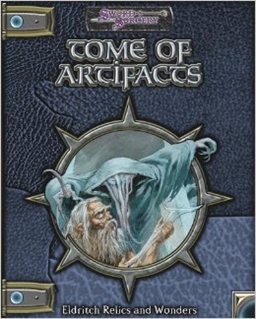 Following in the footsteps of Judges Guild’s Wondrous Relics and preceding Paizo’s Legends and Artifacts (for Pathfinder), this more-than 300-page book contained 50 powerful items: as Zeb Cook said in the introduction, the types of things you built campaigns around, with a history included for each one. Because it’s Necromancer, they lean towards the darkish side. For me, the lack of a cohesive campaign world for the items detracts from the book. It seems kind of like a random collection. Of course, it can still be adapted to fit anybody’s campaign: I get it. But I like when the myths, legends and lore work together. Still, it provides a lot of “stuff” to the reader.
Following in the footsteps of Judges Guild’s Wondrous Relics and preceding Paizo’s Legends and Artifacts (for Pathfinder), this more-than 300-page book contained 50 powerful items: as Zeb Cook said in the introduction, the types of things you built campaigns around, with a history included for each one. Because it’s Necromancer, they lean towards the darkish side. For me, the lack of a cohesive campaign world for the items detracts from the book. It seems kind of like a random collection. Of course, it can still be adapted to fit anybody’s campaign: I get it. But I like when the myths, legends and lore work together. Still, it provides a lot of “stuff” to the reader.
A 3.5 City of Brass Box Set came out in 2007 and was essentially the last hurrah for Necromancer. The longstanding agreement with White Wolf expired and Necromancer established a new one with a post-Dragon Magazine Paizo (one that would pay unexpected future dividends). Necromancer suspected a 4th Edition of D&D was coming, so they temporarily shut things down to assess the environment.
Necromancer was correct: 4th Edition was announced at 2007 GenCon. They planned on a string of 4th Edition releases in conjunction with Paizo, including Tegel Manor and Paizo’s popular 3rd Edition adventure path, The Iron Tower.
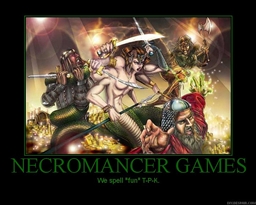 But Wizards was vague regarding the new license and it appeared that the Open Game License would be significantly different for this version. It was, as the new Game System License (GSL) replaced it and drove out nearly all third party producers for the to-be short-lived 4th Edition.
But Wizards was vague regarding the new license and it appeared that the Open Game License would be significantly different for this version. It was, as the new Game System License (GSL) replaced it and drove out nearly all third party producers for the to-be short-lived 4th Edition.
Two of them, Goodman Games and Mongoose Publishing, signed on for 4th Edition, though to not much benefit for themselves. Goodman, which created the retroclone Dungeon Crawl Classics, is currently making 5th Edition modules.
Clark Peterson said, “The bottom line, in my view, is that the GSL is a total, unmitigated failure.” Necromancer effectively packed it in, while Paizo created Pathfinder to compete directly with Wizards’ new version of Dungeons & Dragons.
Necromancer had three products being printed in China when the end came. It wasn’t cost effective to print and bring them back over, so they simply abandoned them. In 2009, they did release all three in pdf format: The Eamonvale Incursion (sort of a sequel to The Gray Citadel), Demonheart and The Slumbering Tsar. All were for use with 3.5 (and would be released in book form by Frog God a few years later).
Inspired by a City of Tsar mention in 2005’s Rappan Athuk, Greg Vaughan had pitched the idea of a mega-dungeon in the ruined city to Peterson and Webb. Rather than a single-volume, Lost City of Barakus-type product, they wanted to do a three-volume adventure. Writing for over a year, Vaughan delivered just that. It was shipped off to China, 4th Edition was announced and Tsar was sacked again. Necromancer did manage to release it as a PDF-only product in 2009.
And there, our saga of Necromancer Games draws to a close. But our story has most certainly not come to an end. Part Two, telling of the rise of the Frog God, can be found here!
Other gaming/RPG-related posts I’ve done:
The Lost Lands for Pathfinder
The Northlands Saga – Complete
The Warlords of the Accordlands
Judges Guild Premium Editions
Gary Gygax’s Role Playing Mastery
Runebound
Runebound – The Sands of Al-Kalim
Runebound – The Mists of Zanaga (coming soon)
You can read Bob Byrne’s ‘The Public Life of Sherlock Holmes’ column here at Black Gate every Monday morning.
He founded www.SolarPons.com, the only website dedicated to the ‘Sherlock Holmes of Praed Street’ and blogs about Holmes and other mystery matters at Almost Holmes.
His “The Adventure of the Parson’s Son” is included in the largest collection of new Sherlock Holmes stories ever published
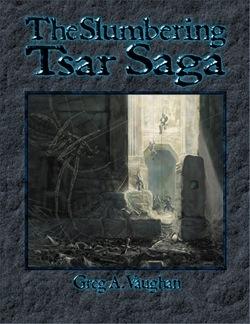
I had another half dozen covers ready to insert into this post. I love the art on those old modules and books.
Hopefully part two, on Frog God Games, will be out in early December. It’s loaded with cool art as well!
Count me as one who believes that the OGL (not D20 per se) helped the overall industry much more than it helped WotC. I would actually go so far as to say it hurt their flagship AD&D brand.
There’s a reason why companies with a valuable brand rigorously enforce branding. In DnD’s case it reaped all of the disadvantages but none of the financial rewards; lose-lose.
The great OGL products that were released shamed WotC by showing them what they should be releasing. The much more plentiful shit diluted the brand.
And the entirely new non-DnD D20 OGL games just outright stole players who didn’t have to buy all the core DnD books to play those games.
It was a needed revival for the whole industry, but came at a disservice to DnD I think.
The real tragedy of it all is that d20 is actually a pretty poor system geared toward tactical number games that pushes story and developing characters into the background. Less “what would my character want to do?”, and more “which die roll would get me the best chance for success”.
Which isn’t a problem when it’s just a single game, but when it becomes the industry standard, it’s really very unfortunate for everyone.
Clearly, Wizards of the Coast wasn’t enamored with the OGL, as they replaced it with the much more restrictive GSL for 4th Edition (like that really mattered). And Ryan Dancey had been laid off by then.
Thanks for the history lesson, Bob. I played 1st and 2nd edition AD&D back in the day (a little basic D&D too from the Moldvay box set). I stopped playing later in high school, college, and grad school, only coming back to RPGs in the last year or so. I didn’t really understand the changes from version 3 until today, but Howard Andrew Jones has persuaded me to buy the 5th edition books. I’ve just started to delve into those, so I don’t yet have a full grasp of how 5th ed is different from what I played with 1st and 2nd.
NOLAbert –
I like Pathfinder. In large part because Golarion is a great world and Paizo puts out quality products on a regular basis.
But as more and more supplements come out, I think Pathfinder is drowning under Options Bloat. And it started out a bit rules heavy (being based on 3.5), so Rules Bloat is a problem as well.
I’ve started looking into the retroclone Swords & Wizardry, which I’ll talk about in Part two. It’s a throwback to the original game (pre-1st Edition).
A quote from Gary Gygax in his book, ‘Role Playing Mastery,’ about what I consider ‘bloat’:
“Too often, new material purporting to add to a game system is nothing more than a veiled attempt to dominate the game milieu through power, not skill. Such creativity, if it can be called that, amounts to a perversion of the game. It is much like cheating at solitaire. Understanding the scope of opportunity offered to PCs by the game system will certainly discourage the intelligent player from such useless activity.”
Any additional option in the rules limits what you can do as a player.
Once you add a special rule for something, many characters no longer have the option to do that thing effectively, and it sets a precedent for what things can be done only under special circumstances instead of always.
Someone called it the Air-breathing Mermaid Problem. First you give the players the option to play a mermaid. Then later you add a special rule that some mermaids can have the ability to breath air. You did not actually allow some players to do something new. You only retroactively removed the option to have a mermaid outside of water from everyone without that new special ability. When it was still unregulated, players and GMs had the option to decide fo themselves how mermaids breath.
And that’s the main flaw of the entire d20 system. It already starts with lots of special rules from the very start and both D&D and Pathfinder piled on more with every single book, in the mistaken believe that they give players more “options”.
Martin – I’m not quite following the Air Mermaid point. ”
When it was still unregulated, players and GMs had the option to decide for themselves how mermaids breath.”
Sort of. Except it wasn’t allowed, so the GM’s default is to not have air breathing mermaids. Though the GM could make an alternate ruling and allow them.
Just as, with the rule, the default is for air breathing mermaids, and the GM has the option to not allow them.
The default is towards more options for the player. I don’t like all the additional rules and options (bloat), but I go the opposite way from you and think they have the opposite effect of limiting what a player can do.
Now, I am buying into the retroclone premise that more rules result in mechanics over storytelling. Which you intimated in your first comment.
The current ‘Lost Lands’ kickstarter, Borderland Provinces, has three days to go and has already hit three stretch goals.
Folks love Necromancer-styled campaign products for Pathfinder/Swords & Wizardry.
https://www.kickstarter.com/projects/froggodgames/the-lost-lands-borderland-provinces/description
[…] at Black Gate this week, I posted Of Necromancers and Frog Gods – Part One. It’s a history of Necromancer, with insights from Black Gaters and Necromancer/Frog God […]
[…] back in November, I did a long post on 3rd Edition D&D company, Necromancer Games. It was a pretty neat look at their history. […]